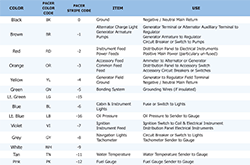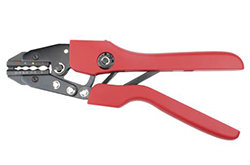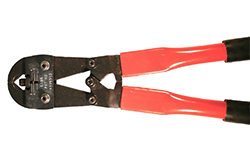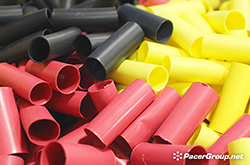The Most Common Connectors You’ll Need on Your Boat.
Posted by Pacer on 2nd May 2022
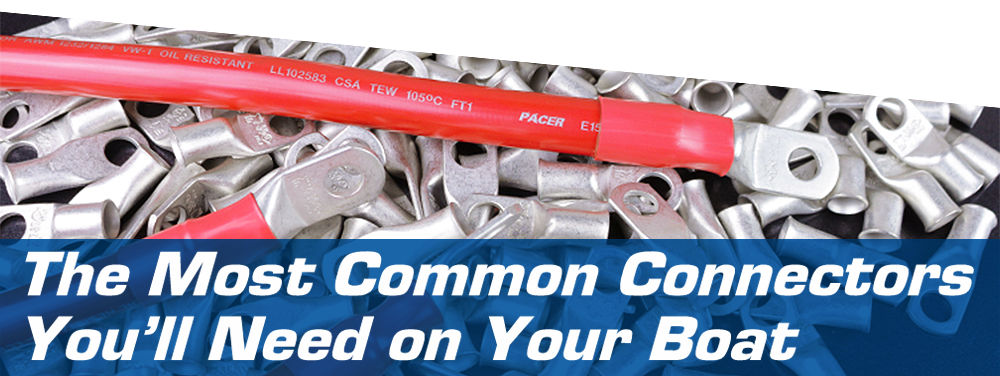
When it comes to dealing with your boat’s electrical system, understanding the most common electrical connector types is essential. Knowing how to identify, maintain, and replace your electrical connectors can mean the difference between having an amazing day on the water or dealing with engine trouble or worse yet, being stranded on the water. Let us look at the most common types of connectors you are likely to encounter on your boat. We will look at how they are used, the tools you’ll need, and other important factors to consider. With that out of the way, let’s dive right in and start with terminal kits.
Terminal Kits
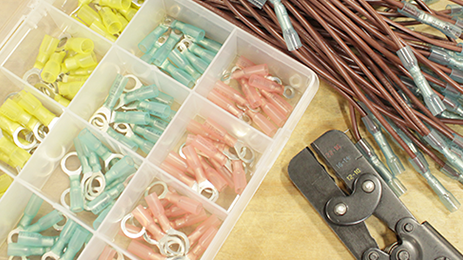
Terminal kits are exactly what they sound like, kits with terminals in them. The thing that makes Pacer terminal kits so useful is the fact that they carry not only the most popular electrical wire connectors, but they carry them in the most commonly encountered sizes. Terminal kits are available in either nylon or heat shrink insulation allowing each individual to get the exact kit that they need. Terminal kits are designed for field service meaning that they are intended to be used on job sites, in repair shops, in marinas, and other, similar locations. This makes them ideal for use on private boats as well. The efficient sizing of the box allows for Pacer terminal kits to be easily stored away on a vessel when needed. To make these terminal kits even better, their protective case can be reused repeatedly. Made from highly durable plastic, they are built to withstand minor abrasion and impact. Now that we have covered just how useful terminal kits are, we can turn our attention to the connectors you will want to be familiar with.
Connectors you’ll want to have onboard
![]()
Rings – Ring terminals are widely known for the semi-permanent connections that they create. They are used to connect a wire to a solid connection point like a stud or screw. They are an extremely secure option as they cannot be removed without first removing the screw or locking nut that holds them in place. Available in sizes ranging from 22 gauge all the way down to 10 gauge, these crimp connectors can handle most applications on a marine vessel. To make ring terminals even better, they can easily be used with two or more wires depending on the application. Ring terminals are the most secure types of crimp connectors available and are commonly chosen for their durability, ease of use, and longevity in tough conditions.
![]()
Forks – Fork terminals are somewhat like ring terminals although the connection that they create is less permanent. Whereas ring terminals fit over a stud or screw, fork terminals fit around them. This makes fork terminals more convenient as you do not need to fully remove the screw or locking nut. Instead, you only need to loosen the connection enough so that the fork terminals can lock onto the screw or stud. Once that is done all you need to do is retighten the screw or locking nut to secure the fork terminal in place. Fork terminals are available to two distinct types, locking forks and flanged forks. A locking fork terminal has projections inside the fork body. These projections cause the terminal to snap onto the screw. This action creates a strong bond and reduces the risk of the connection coming loose. A flanged fork terminal on the other hand has the ends of the forks turned up. This action causes the fork terminal to grip the screw or mount that it is attached to. This gripping action snuggly holds the point of contact and further reduces the chances of the fork terminal coming loose.
![]()
Disconnects – Disconnects are different from other terminals in that they are designed to be disconnected and reconnected multiple times. They are commonly implemented in applications where conditions require equipment to be maintained more frequently. Regardless of whether you’re dealing with mechanical abuse, abrasion, or another hazard, disconnects are a solid choice for long-term conductivity. One of the most advantageous benefits offered by disconnects is they are ideal for field service. Whereas other terminals do not allow for a connection point to be manipulated, disconnects are designed for it. One thing about disconnect terminals is they are available in a host of different styles to meet the widest range of needs. These can take the form of partially insulated disconnects, fully insulated disconnects, bullet terminals, piggyback terminals, pin terminals, and several other types.
![]()
Splices – Splices are a common type of connector that is often used to connect a wire to another wire. They can even be used to connect one or more wires to another wire or set of wires. Splices differ from most other connectors in a few ways such as the permanence of the connection and the way in which they are installed. Other connectors such as ring terminals create a semi-permanent connection that can be adjusted if needed. A splice on the other hand creates a permanent connection point that can no longer be separated. This is important in hazardous conditions where the connection point needs the highest level of protection possible. Another difference is that splices can be connected in the middle of a wire whereas other terminals are connected onto the ends of the wire.
![]()
Lugs – Lugs are like ring terminals mentioned earlier in that they fit over a screw body or a stud. They create a similar semi-permanent, long-lasting connection point. The difference is in their construction and gauge sizes. Basically, lugs are large, rugged ring terminals built to handle large battery cables. Lugs are commonly available in gauge sizes ranging from 8 gauge all the way down to 4/0 aught. The most common types of lugs you will find are closed-end lugs and brazed seam lugs. The main difference between them is that closed-end lugs have a closed-face barrel whereas brazed seam lugs have an open-faced barrel. Lugs are also made from 100% pure copper to ensure that offer the highest level of conductivity. This copper has been fully annealed to prevent any cracking while in service or while being crimped.
Now that we have covered the most common types of wire connectors, you’re likely to find on your boat, let us briefly take a look at the various types of insulation.
Types of Insulation
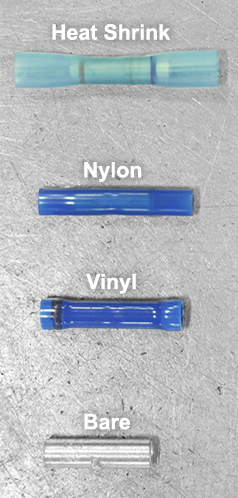
We have covered the topic of insulation in-depth in this article, so if you are looking for a more robust explanation, it’s the place to start. Here, we will quickly look at the different types of insulation.
Heat Shrink
This is the gold standard. The highest level
of protection possible. Epoxy-lined heat shrink creates an environmental seal
that protects against moisture intrusion as well as a host of other
environmental factors.
Nylon
Nylon
is used in a range of applications such as marine environments, the automotive
industry, appliances, and electrical equipment. The reason this one is so
popular is that it is simple to crimp and requires no additional effort on the
part of the operator.
Vinyl
This type of insulation is useful in environments where moisture or
other contaminants are not a major concern. These are a solid choice for use where
the electrical connections are in-between walls and are not subject to
vibration, flex, or any other type of hazard.
Bare
Non-insulated terminals offer protection from impact
and abrasion and that’s about it. They are built for durability and longevity.
To be honest, the reason people still use them is the fact that they are cost-effective.

Other Important Considerations
Do you know what the standard color codes mean?
Did you know that the color of a wire’s insulation can indicate its intended function? Think about it, most modern boats have pretty complex wiring systems that can run twenty, thirty, and even fifty feet in length. Now add in the fact that wires run in between walls and through hidden compartments as well as the fact that they are often bundled with other wires, and you can imagine how hard it is to figure out which wire is connected to what. The American Boat and Yacht Council created standards that are designed to simplify the wiring process. Understanding the various wire colors and what they indicate can make maintenance and replacement a much simpler task. Tell you what, just print out this handy chart you see here and keep it on your vessel.
Do you have the proper tools?
What good are connectors if you cannot connect them? Having the proper tools is an absolute must, especially when performing on-the-spot maintenance. Having a few good tools on your vessel at all times is essential. Check out the tools below to see which ones can handle the terminals you’ll be working with.
Ratcheting Crimper for 22 – 8 AWG Terminals
This tool will be your primary go-to. This type of crimper can work with rings, forks, disconnects, and splices. Additionally, it can handle heat shrink, nylon, and vinyl insulations. So, in short, this tool can nearly do it all. Its ratcheting action allows for the exact crimp pressure each and every time. You will find this tool not only in repair shops and private toolboxes but on production lines and in industrial facilities as well. That goes to show just how potent this tool actually is.
Crimp Master Crimp tool for 6 – 4/0 AWG Terminals
This tool can handle the toughest lugs out there. If you need to crimp a 4/0 aught closed-end lug onto a battery cable, this tool can handle it. One great aspect of this tool is the fact that it is universal and adjustable. That means that it can handle a wide range of tasks. The 25” long, high-leverage handles make crimping any lug a simple job. The compound action mechanism is designed to allow the operator to complete crimps faster than other tools can achieve.
Are you keeping heat shrink on hand?
Heat shrink is an essential component when it comes to electrical systems in a marine environment. Epoxy-lined heat shrink creates the environmental seal we mentioned above. This seal keeps moisture, oil, salt, and other contaminants from affecting the electrical connection. Heat shrink can also offer abrasion and impact resistance and basically works like a form of armor. Imagine you go through all the trouble to cut and strip your cable and then terminate the lug only to find out that it has corroded from exposure to the harsh marine environment. Now you have to replace the cable, the terminal, and possibly the post it is connected to. All that could have been avoided if you used the proper type of heat shrink. We cannot stress the importance of heat shrink enough. By properly utilizing heat shrink you can give your electrical system the protection that it needs.
And there you have it. We covered the most common types of connectors you’ll run into on a boat, the types of insulation, the tools you’ll need, and even wire color standards and the importance of heat shrink. Now you hopefully have a better understanding of your electrical system along with some tips to keep it in the best shape possible.

